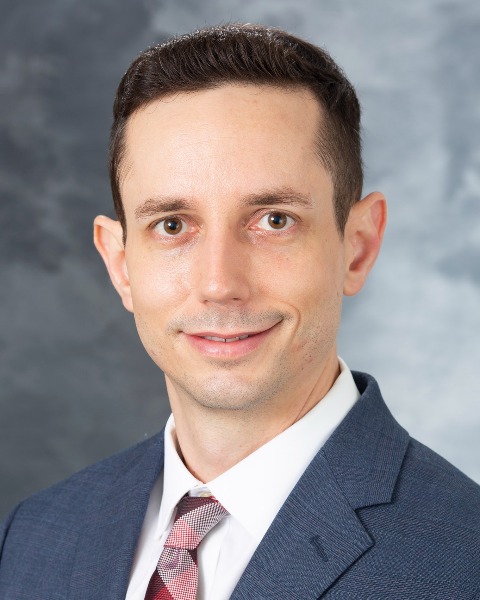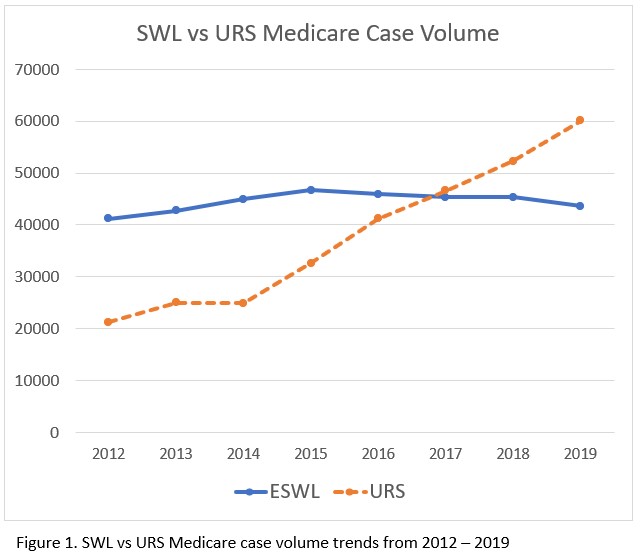Back
Poster, Podium & Video Sessions
Moderated Poster
MP28: Health Services Research: Practice Patterns, Quality of Life and Shared Decision Making III
MP28-05: Stone Surgery Trends from 2012-2019 within the Medicare Utilization and Payment Data: Sharp Growth in Ureteroscopy Utilization with Diminishing SWL Utilization
Saturday, May 14, 2022
1:00 PM – 2:15 PM
Location: Room 228
Christopher Haas*, Margaret Knoedler, Kristina L. Pennniston, Stephen Y. Nakada, Madison, WI

Christopher R. Haas, MD
University Of Wisconsin
Poster Presenter(s)
Introduction: Both ureteroscopy and SWL are cornerstones in the surgical management of urolithiasis. Guidelines for surgical management of upper urinary tract calculi recommend either shock wave lithotripsy (SWL) or ureteroscopy (URS) depending on stone size and position. We hypothesized that ureteroscopy utilization grew faster in recent years than SWL and sought to quantify the magnitude of change.
Methods: Using the Medicare “Provider Utilization and Payment Data: Physician and Other Supplier Public Use File” (https://data.cms.gov) from years 2012 - 2019, we determined case volumes of SWL (CPT 50590) and URS (CPT 52356 or 52353) for individual urologists. We considered a “high volume stone urologist” to be in the upper quartile of case volume for both SWL and URS in baseline years of 2012 - 2013. Data were analyzed using SPSS 25 to generate summary statistics and linear regression estimates of annual change.
Results: Six thousand one hundred and sixty-nine unique urologists performed either SWL or URS on Medicare patients from 2012 - 2019. In 2012 SWL was the preferred modality with 41,135 SWL performed vs. 21,184 URS. URS volume overtook SWL in 2017 and by 2019 was the dominant treatment modality (60,063 vs 43,635 SWL, figure 1). From 2012 – 2019, each additional year saw an estimated growth of 5,700 total URS cases (p <0.001), while SWL volume did not significantly increase (370 cases/year, p = 0.21). In fact, after 2015 SWL volumes declined by nearly -2%/yr in contrast to URS which grew 14%/yr within the observation period. Examination of high-volume stone urologists after 2015 showed an even greater reduction in SWL (-6.3%/year) and an increase in URS (4.6%/year). With the average surgeon’s URS case volume minimally increasing from 18.5 in 2012 to 21.4 in 2019, the majority of growth in URS volume is explained by the more than doubling of unique urologists performing URS from 1,147 in 2012 to 2,809 in 2019.
Conclusions: URS utilization has outpaced SWL in recent years within the Medicare population. Since 2015, URS saw growth amongst both new urologists and among established high-volume stone surgeons while SWL case volumes diminished. Factors driving these changes in this practice pattern should be explored.
Source of Funding: none

Methods: Using the Medicare “Provider Utilization and Payment Data: Physician and Other Supplier Public Use File” (https://data.cms.gov) from years 2012 - 2019, we determined case volumes of SWL (CPT 50590) and URS (CPT 52356 or 52353) for individual urologists. We considered a “high volume stone urologist” to be in the upper quartile of case volume for both SWL and URS in baseline years of 2012 - 2013. Data were analyzed using SPSS 25 to generate summary statistics and linear regression estimates of annual change.
Results: Six thousand one hundred and sixty-nine unique urologists performed either SWL or URS on Medicare patients from 2012 - 2019. In 2012 SWL was the preferred modality with 41,135 SWL performed vs. 21,184 URS. URS volume overtook SWL in 2017 and by 2019 was the dominant treatment modality (60,063 vs 43,635 SWL, figure 1). From 2012 – 2019, each additional year saw an estimated growth of 5,700 total URS cases (p <0.001), while SWL volume did not significantly increase (370 cases/year, p = 0.21). In fact, after 2015 SWL volumes declined by nearly -2%/yr in contrast to URS which grew 14%/yr within the observation period. Examination of high-volume stone urologists after 2015 showed an even greater reduction in SWL (-6.3%/year) and an increase in URS (4.6%/year). With the average surgeon’s URS case volume minimally increasing from 18.5 in 2012 to 21.4 in 2019, the majority of growth in URS volume is explained by the more than doubling of unique urologists performing URS from 1,147 in 2012 to 2,809 in 2019.
Conclusions: URS utilization has outpaced SWL in recent years within the Medicare population. Since 2015, URS saw growth amongst both new urologists and among established high-volume stone surgeons while SWL case volumes diminished. Factors driving these changes in this practice pattern should be explored.
Source of Funding: none


.jpg)
.jpg)